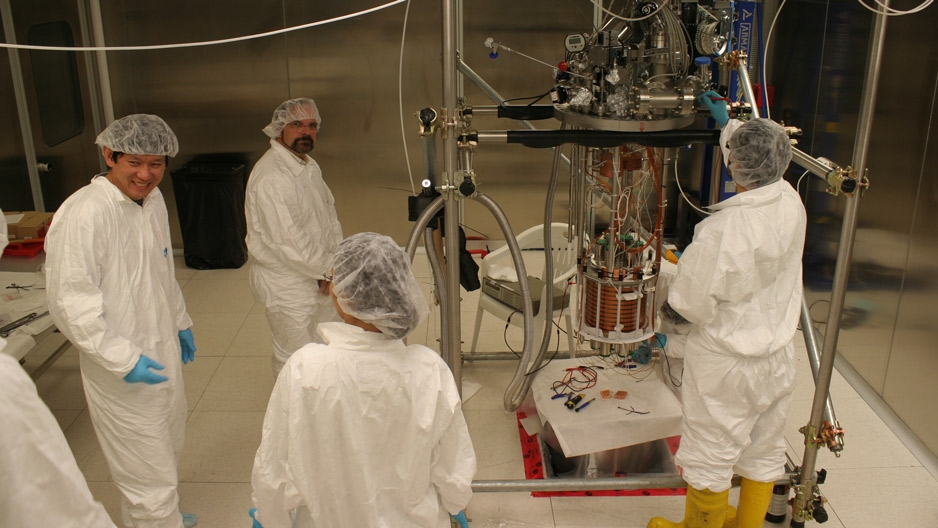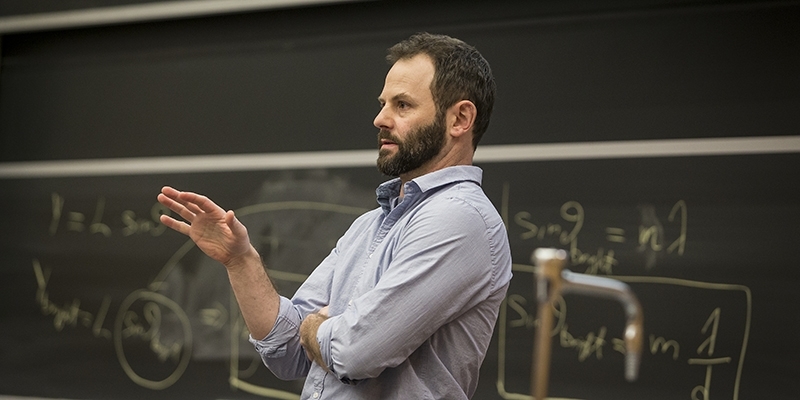Posted September 20, 2017
Temple physicist wins prestigious W. M. Keck Foundation grant to investigate dark matter
Jeff Martoff and collaborators at UCLA and the University of Houston to build a new experiment targeting a novel particle to explain the elusive phenomenon.

Photography By:
Courtesy Jeff Martoff
Jeff Martoff (second from left), the recipient of Temple’s first W. M. Keck grant, is also a longtime National Science Foundation-funded principal investigator in the DarkSide search for WIMP dark matter. In 2012, he helped assemble DarkSide 10, an earlier prototype of the current DarkSide WIMP detector, a mile underground at the Laboratorio Nazionale Gran Sasso, a particle physics laboratory near the Gran Sasso mountain in Italy.
The National Academy of Sciences has called it the No. 1 unanswered question facing astrophysicists today: What is dark matter?
It's the mystery Temple University physicist Jeff Martoff is seeking to solve with the support of a prestigious $1.2 million grant from the W. M. Keck Foundation, which funds pioneering efforts in the areas of medical research, science and engineering, and undergraduate education.
This is the first time a Temple investigator has received a Keck award.
Although dark matter has not been directly observed, physicists believe it comprises most of the mass of the universe and exists in the vast darkness that surrounds galaxies. Evidence indicates that it is not even made of ordinary matter—protons, electrons and neutrons.
“The whole thing is very embarrassing to physicists, or should be if they have any sense,” Martoff said. “On one hand, we’re saying we know how everything works, from atoms to the solar system, in great mathematical detail, and yet on the other hand, we know there’s a big piece missing. More than two-thirds of the universe’s mass is made out of something we don’t understand at all and have not even identified.”
Video Production:
Gina Benigno
If you view the night sky through a telescope and look closely at a galaxy, you see a swirl of stars and brightness. But most of what is actually there is invisible to the human eye and to any instrument yet invented. Scientists call it dark matter, and it makes up two-thirds of the mass of the universe. Though we can’t see dark matter, it shows its existence by its gravitational effects on objects and particles in space.
Specifically, when physicists examine the orbital speeds and paths of light of different visible parts of a galaxy, such as its stars and gas clouds, the results reveal a much larger mass than what we expect from adding up the masses of the visible parts, Martoff said. The unexplained portion of the mass is thought to be dark matter. Its presence is also betrayed by the bending of light passing by distant galaxies, an effect predicted by Einstein’s general theory of relativity and confirmed in our own solar system using the sun.
Current methods in the race to find dark matter include particle accelerators—the CERN Large Hadron Collider (LHC) in Switzerland is the largest—and sensitive detectors located in labs deep underground. Both methods target “weakly interacting massive particles” (particles known as WIMPs), which are predicted in elementary particle theories and are widely considered good candidates for making up the dark matter. Although more and more stringent WIMP searches have been done, they continue to come up empty.
Martoff will test a new, highly interdisciplinary technique and seek a different candidate for dark matter. With colleagues from the University of California, Los Angeles and the University of Houston, he is building a 12-foot-long “tabletop” spectrometer (compared to the 17-mile diameter of the CERN Large Hadron Collider) to search for the presence (or absence) of sterile neutrinos. These are as-yet undiscovered particles that theorists say should also exist, and if detected, would constitute the first visible evidence of a good candidate for a dark matter particle (see sidebar for more on WIMPs and sterile neutrinos).
Martoff and his colleagues believe the existence or nonexistence of sterile neutrinos can be detected in the laboratory using kinematics to measure the energy and mass of the particles—an atom, an electron and an X-ray—produced by a specific kind of radioactive decay and then examine what is missing. The decay also produces a neutrino, which may be the ordinary type or the sought-after sterile type. These differ mainly in their mass, with the ordinary neutrinos being nearly massless and the sterile neutrinos having mass 2 percent or greater than that of the electron. Both neutrino types are nearly impossible to detect directly.
“We believe we can conduct an extremely sensitive and precise measurement of the
energy and momentum of these particles,” explained Martoff. “This will reveal missing energy and momentum from which we can compute the masses of the undetected neutrinos.”
Overall, Martoff’s work is expected to lead to a deeper understanding of particle physics and help explain why dark matter exists.
Based in Los Angeles, the W. M. Keck Foundation was established in 1954 by the late W. M. Keck, founder of the Superior Oil Company. The foundation’s grantmaking is focused primarily on pioneering efforts in the areas of medical research, science and engineering, and undergraduate education. The foundation also maintains a Southern California Grant Program that provides support for the Los Angeles community, with a special emphasis on children and youth. For more information, visit wmkeck.org.


